Knee
- ACL Anatomy
- ACL Injuries
- ACL Injuries Non-Surgical Treatment
- ACL Injuries Surgical Treatments
- Pediatric ACL Injuries
- Recovering from ACL Surgery
- Patient Resources
ACL Anatomy
There are three bones that make up the knee joint – the femur (thigh bone), the tibia (shin bone), and the patella (kneecap). There are two cruciate ligaments—Anterior Cruciate Ligament (ACL) and Posterior Cruciate Ligament (PCL)—inside the knee joint that cross to form an X. The ACL sits in the front of the knee joint, while the PCL sits in the back of the knee joint. Together, they help control the front-to-back motion of the knee, as well as rotation.
What is the ACL?
The ACL is one of two cruciate ligaments in the knee joint that cross to form an X. It is a vital structure that helps stabilize the knee and control its movement. The primary function of the ACL is to prevent excessive forward movement of the tibia relative to the femur, as well as controlling rotational movements of the knee. It works in conjunction with other ligaments and structures in the knee to provide stability and support during activities like walking, running, jumping, and pivoting.
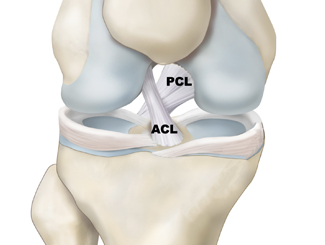
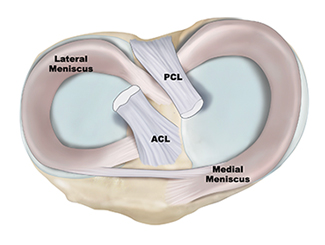
What does the ACL work?
The purpose of the ACL ligament is to prevent the tibia from sliding in front of the femur. The ACL also acts to stabilize the knee during rotation. The ACL runs diagonally from the back of the femur to the front of the tibia in order to provide this stability. The ACL ligament contains important nerve fibers that tell your brain where your knee is positioned, as well as vessels that help with the overall nutrition of the ACL.
Schedule a knee consultation
If you or a family member have suffered an ACL injury, schedule a consultation with Dr. Jorge Chahla. Dr. Jorge Chahla is a highly regarded knee surgeon with offices in Chicago, Naperville, and Oak Brook. He focuses on the comprehensive diagnosis and advanced treatment of ACL injuries, helping patients regain stability and function. If you are experiencing knee instability, swelling, or challenges with weight-bearing, schedule a consultation with Dr. Chahla to explore personalized treatment options and begin your path toward restoring knee health.
If you or a family member have suffered an ACL injury, schedule a consultation with Dr. Bryan Penalosa. Dr. Bryan Penalosa is a highly regarded knee surgeon with offices in Chicago, Naperville, and Oak Brook. He focuses on the comprehensive diagnosis and advanced treatment of ACL injuries, helping patients regain stability and function. If you are experiencing knee instability, swelling, or challenges with weight-bearing, schedule a consultation with Dr. Penalosa to explore personalized treatment options and begin your path toward restoring knee health.
ACL Injuries
What are the symptoms of an ACL injury?
When you injure your ACL, you may hear or feel a “pop” at the time of injury, often coupled with buckling of the knee. There will be immediate and intense knee pain, swelling, inflammation, redness, and bruising. While the pain may eventually decrease, the knee often remains unstable—especially when attempting to pivot or change direction quickly. You may also experience a loss of knee range of motion following an ACL injury.
Additionally, symptoms such as tenderness along the knee joint or locking of the knee may occur if there is an associated meniscus tear. Continuing regular activities with an ACL deficiency may lead to repeated instability episodes, which can cause further damage to structures like the meniscus and cartilage.
If you feel that you may have suffered an ACL injury, it is important to have it evaluated by a well-regarded knee surgeon, like Dr. Bryan Penalosa, as soon as possible.
How do ACL injuries occur?
Traumatic injury to the ACL occurs in athletes who participate in high-risk sports such as skiing, soccer, football, and basketball. The majority of ACL injuries result from a sharp twisting of the knee; sudden deceleration while cutting, pivoting, or performing sidestepping movements; an abrupt stop when running, or an awkward landing from a jump. Other, less common, causes include direct contact, a fall, or a traumatic accident. Women who participate in college sports, such as soccer, basketball, softball, lacrosse, or rugby are four times more likely than men to rupture their ACL.
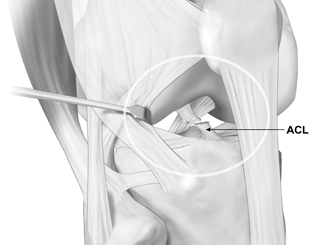
How do you diagnose an ACL injury?
The combination of a detailed history, comprehensive physical examination, x-rays, and an MRI (magnetic resonance imaging) is key to successfully diagnosing an ACL injury. Knee surgeon Dr. Bryan Penalosa and his team use stability tests as part of the physical exam, including the Lachman and Anterior Drawer tests, to properly diagnose an ACL injury. Because almost half of all ACL injuries occur in combination with other knee injuries, imaging studies such as an MRI are important to fully evaluate the extent of your injuries.
What are the types of an ACL injury?
ACL injuries can be classified into different types based on the severity and extent of damage to the ACL fibers. The grading of severity is based on the amount of ligament disruption and the level of knee instability present following an injury. It is important to accurately diagnose the extent of an ACL injury, as the appropriate treatment plan can vary depending on the type of ACL injury an individual has suffered.
Grade 1: ACL Sprain
An ACL injury that stretches the fibers of the ligament but does not lead to a full-thickness tear is called an ACL sprain. This is the least severe type of ACL injury, and often these injuries can heal on their own with conservative treatment, including rest, ice, compression, elevation, oral anti-inflammatory medications, and physical therapy.
Grade 2: Partial ACL Tear
An ACL injury that tears some of the ligament fibers is called a “partial tear.” When a partial tear occurs, patients may experience episodes of mild instability or pain. The severity can vary depending on how much of the ACL is torn. In some cases, a partial ACL tear may heal with conservative treatment such as rest, ice, compression, elevation, anti-inflammatory medications, physical therapy, and possibly the use of a specialty brace known as a functional ACL brace.
However, if instability persists despite conservative treatment, it may be necessary to consider surgical intervention. The decision to proceed with surgery depends on the degree of knee instability and the patient’s desire to return to sports. When discussing surgery for a partial ACL tear, knee surgeon Dr. Bryan Penalosa and his team may consider both ACL repair and ACL reconstruction options. The best option for you will depend on the location and extent of your partial tear. Please review the treatment section below for more information.
Grade 3: Complete ACL Tear
A complete ACL tear occurs when the ligament is fully torn and becomes non-functional. This type of injury typically requires surgical treatment. Professional athletes and most recreational athletes will likely need surgery to return to play, especially if their sport involves cutting, pivoting, or lateral movements.
A torn anterior cruciate ligament (ACL) is a serious knee injury that can significantly affect your ability to walk, run, or participate in sports. Whether caused by a sudden twist, direct impact, or a non-contact pivot, an ACL injury often results in instability and persistent knee pain. Dr. Bryan Penalosa, a leading orthopedic knee surgeon with offices in Chicago, Naperville, and Oak Brook, specializes in the diagnosis and treatment of ACL injuries. If you have experienced knee instability, swelling, or difficulty bearing weight, contact Dr. Bryan Penalosa to discuss your treatment options and take the first step toward restoring your knee function.
A torn anterior cruciate ligament (ACL) is a serious knee injury that can affect your ability to walk, run, or participate in sports. Whether caused by a sudden twist, direct impact, or a non-contact pivot, an ACL injury often leads to instability and persistent knee pain. Dr. Bryan Penalosa, a leading orthopedic knee surgeon with offices in Chicago, Naperville, and Oak Brook, specializes in the diagnosis and treatment of ACL injuries. If you have experienced knee instability, swelling, or difficulty bearing weight, contact Dr. Penalosa to discuss your treatment options and take the first step toward restoring your knee function.
ACL Injuries Non-Surgical Treatment
Can an ACL tear be treated without surgery?
In some cases, conservative treatment may be appropriate, especially for patients with incomplete ACL injuries such as an ACL sprain or a partial ACL tear. Conservative treatment can be a successful option for patients who do not plan to return to pivoting sports or for those willing to wear a functional ACL brace to help control instability during such activities. However, patients with full-thickness ACL tears who wish to return to high-risk or pivoting sports will most likely require surgical intervention to regain their desired level of function and prevent further damage to other knee structures, including the menisci and cartilage, as a complete ACL tear will not heal on its own.
For patients who are candidates for conservative treatment, the focus of care is on reducing pain, swelling, and inflammation, while also improving overall knee stability and function.
Rest and Activity Modification
Initially following the injury, it is essential to rest the knee and avoid activities that worsen pain or cause instability. As previously mentioned, repeated episodes of instability can lead to further damage to other structures in the knee joint, including the menisci and cartilage. Therefore, activities involving pivoting, lateral movements, cutting, jumping, or quick deceleration while running should be avoided after an ACL injury to prevent additional instability episodes.
Oral Anti-Inflammatories, Ice, and Compression
Oral anti-inflammatory and pain-relieving medications, such as Meloxicam, Naproxen, Advil, or Ibuprofen, may help to manage the pain and reduce inflammation of the knee following an ACL injury. Applying ice packs and compression to the knee can also help reduce swelling and inflammation. Remember to use a cloth or towel between the ice pack and your skin to avoid frostbite.
Physical Therapy
A structured physical therapy program can be beneficial for strengthening the muscles around the knee and improving overall joint stability. A physical therapist can guide you through exercises that focus on the quadriceps, hamstrings, and calf muscles to provide this additional support to the knee. Additionally, proprioceptive training can enhance knee stability. Proprioception is the body’s ability to sense joint position and movement, and improved proprioception can help with knee stability and control during activities. It is important to complete any home exercises that your physical therapist provides to you in order to optimize your recovery.
Functional ACL Brace
A functional ACL brace is a type of knee brace designed to provide support and stability to the knee joint, particularly for individuals with an ACL injury or instability. While a functional brace cannot fully replace the role of the ACL, it can help limit certain movements that could put additional stress on the knee and reduce the risk of further injury during physical activities. Here’s how a functional ACL brace works:
Mechanical Support
The brace provides mechanical support to the knee by limiting excessive movements, such as forward sliding of the tibia relative to the femur. Recall, that this is the primary function of the ACL.
Stabilization
The functional brace helps stabilize the knee joint by restricting certain ranges of motion. For example, it can prevent excessive hyperextension and limit rotational movements that might strain the injured ACL or destabilize the knee.
Protection
By restricting certain movements and providing stability, the brace can protect the knee from further injury during physical activities or sports, most specifically downhill skiing.
It’s important to note that while functional ACL braces can provide some benefits, they are not a substitute for proper rehabilitation or surgical management, especially in cases of complete ACL tears. Functional braces are more commonly used for individuals with partial ACL tears or those returning to downhill skiing following an ACL reconstruction.
Intra-Articular Knee Injections
The goal of an intra-articular injection is to manage pain and inflammation of the knee. Therefore, injections may be used as a short-term measure to manage these symptoms following an injury. However, it’s crucial to understand that an intra-articular injection will not heal the torn ACL itself, nor will it provide long-term stability to the knee. Additionally, receiving an intra-articular injection to the knee will delay any surgical intervention for at least 3 months following the administration of the injection.
ACL Injuries Surgical Treatments
Overview
What are the surgical options for an ACL injury?
Studies report that patients with an ACL injury may benefit from beginning physical therapy prior to ACL surgery to strengthen the muscles surrounding the knee, particularly when their range of motion is limited. This is called prehabilitation. Once a patient has at least 0–90 degrees of range of motion, knee surgeon Dr. Bryan Penalosa will discuss moving forward with surgical intervention. Generally, delaying surgery until pain, swelling, and inflammation have decreased—and range of motion has been restored through physical therapy—results in the best outcomes.
The timing of ACL surgery is determined on a case-by-case basis, depending on each patient’s symptoms and overall knee function.
How is an ACL injury fixed?
Knee arthroscopy is a minimally invasive procedure used to view, assess, and treat a torn ACL. A torn meniscus—commonly found with an ACL rupture—can also be repaired during a knee arthroscopy.
ACL injuries can be treated arthroscopically either by repairing the ACL or reconstructing it. Because only a very specific type and location of partial ACL tear qualifies for an ACL repair, reconstruction is often the best option to achieve a full recovery. The decision to repair versus reconstruct the ACL will be discussed during your appointment with knee surgeon Dr. Bryan Penalosa, based on your physical exam findings, MRI results, and the severity of your injury.
ACL reconstruction
ACL reconstruction is a surgical procedure used to replace a torn anterior cruciate ligament (ACL) with a graft, typically sourced from the patient’s own tendon (autograft) or a donor tendon (allograft). This procedure is often recommended when the ACL tear is complete or located in an area where repair is unlikely to succeed. ACL reconstruction aims to restore knee stability, improve function, and allow a return to physical activity.
The graft is carefully secured using minimally invasive techniques, such as arthroscopy, to ensure precision and reduce recovery time. Following surgery, a structured rehabilitation program is essential to optimize outcomes, rebuild strength, and restore full range of motion. ACL surgeon Dr. Bryan Penalosa will discuss your specific surgical plan and graft options based on the severity of your injury, activity level, and personal goals.
ACL repair
ACL repair is a surgical option reserved for select cases of partial ACL tears where the ligament’s structure and attachment site are conducive to healing. During the procedure, the torn portion of the ACL is reattached to the bone using advanced arthroscopic techniques to promote natural healing. ACL repair is typically considered for patients with specific tear patterns, such as proximal tears, which are more likely to heal successfully.
While ACL repair is less common than reconstruction, it can be a viable option for some individuals, particularly younger patients or those with minimal ligament damage. During your consultation with ACL surgeon Dr. Bryan Penalosa, the decision to pursue ACL repair will be based on your MRI results, the location of the tear, and your overall knee stability. Rehabilitation following ACL repair focuses on protecting the repaired ligament while gradually restoring strength and mobility.
ACL Reconstruction
ACL reconstruction involves the replacement of the ruptured (torn) ligament with a tendon graft. Graft tissue is either taken from the patient (autograft) or from a tissue donor (allograft).
The source of the graft tissue and the surgical technique depend on the severity of the injury, the patient’s age, activity level, desired outcome, and knee surgeon Dr. Bryan Penalosa’s preferred method. Each type of graft has its advantages and disadvantages, so it is important to discuss any questions you may have with Dr. Penalosa during your appointment as you choose from the graft options below: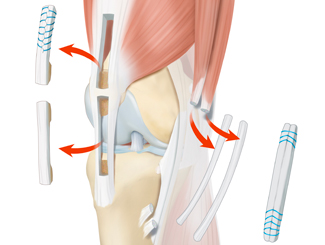
Bone-Tendon-Bone Patella Autograft
Bone-patellar tendon-bone (BTB) autograft ACL reconstruction has the longest proven track record of successful outcomes and is the technique to which all others are compared. In general, autografts have better long-term outcomes and a lower risk of complications compared to other graft types. The BTB Autograft, in particular, is the gold standard graft choice for ACL reconstructions of young, active patients because of its strong bone-to-bone fixation properties. The BTB autograft is harvested from the central third of the patient’s patellar tendon, along with bone plugs from the patella (kneecap) and tibia.

Bone-Tendon-Bone Patella Allograft
BTB Allografts are grafts sourced from a donor (cadaver). They are processed and preserved by tissue banks and can be readily available for surgery. The main advantage of allografts is that they avoid the need to harvest tissue from the patient’s own body, reducing additional surgical sites and potential donor site morbidity. However, there is a slightly higher risk of graft failure, though the risk is still relatively low. These are often times a good graft selection for middle-aged or older individuals who are not planning to return to sports/activities that lead to excessive strain on the ACL (pivoting, cutting, rapid change in speed/direction, etc.)
Quadriceps Tendon Autograft
More recently, the quadriceps tendon autograft has gained popularity as a graft source for ACL reconstruction; however, further data is necessary for a more widespread use. This graft is harvested from the patient’s quadriceps tendon, with or without bone plugs from the patella. This is typically the graft of choice when performing an ACL reconstruction on a pediatric patient whose growth plates remain open (ACL Reconstruction using Physeal-Sparing Technique). Open physes are an x-ray finding that knee surgeon Dr. Chahla will bring to your attention during your consultation should your images reveal this.
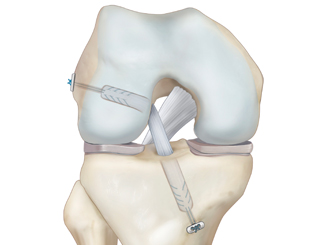
Hamstring Tendon Autograft
In this technique, the semitendinosus and gracilis hamstring tendons are harvested from the patient’s own hamstring muscle. The hamstring tendon autograft is considered less invasive than the patellar tendon autograft. However, the re-tear rate associated with hamstring tendon autografts is higher compared to other graft choices. Additionally, the hamstring tendons act as a secondary stabilizer of the knee joint. For this reason, knee surgeon Dr. Bryan Penalosa does not typically recommend the hamstring tendon autograft for patients undergoing ACL reconstruction.
ACL Repair
ACL Repair
In specific cases, ACL repair may be considered as a treatment option for a partial ACL injury. Due to the vascular supply within the ACL and its healing potential, the location of the partial ACL tear plays a critical role in deciding whether repair is possible. The Sherman classification describes the location of an ACL tear and is used to categorize tears that may be suitable for repair.
Sherman Type I: ACL avulsion injury from the top of the femoral notch.
Sherman Type II: Tear through the substance of the upper one-third of the ACL.
Primary Sherman Type I or II ACL injuries with good tissue quality and no other ligament injuries may be considered for potential ACL repair. Additionally, to optimize tissue quality, it is essential to repair an ACL as soon as possible—ideally within 40 days of injury—once the patient has achieved 0–90 degrees of range of motion.
Arthroscopic primary repair is a minimally invasive procedure. Since no grafts need to be harvested, the surgical incision is smaller than that of an ACL reconstruction with an autograft. Nonmetal anchors and sutures are used to reattach and re-tension the ACL remnant during surgery. The goal of the procedure is to preserve the native ACL, maintaining its nerve endings and blood supply, which promotes healing and preserves proprioception.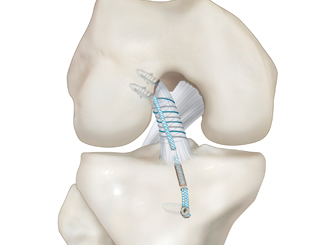
When an ACL injury is suitable for arthroscopic repair, ACL surgeon Dr. Bryan Penalosa will also discuss the option of augmenting the repair with the BEAR technique: Bridge-Enhanced ACL Repair. Due to the natural supply of synovial fluid within the knee joint, the ACL is unable to heal on its own because blood clots cannot form. This prevents the healing components of blood—such as platelets, coagulation factors, growth factors, and fibrin—from reaching the damaged ACL tissue.
The BEAR implant is designed to hold the body’s own blood within the gap of the ACL injury, allowing a blood clot to form and the healing process to occur. In other words, the BEAR implant acts as a bridge between the torn edges of the ACL as it heals. Although short-term data on the use of the BEAR implant in ACL repairs has been promising, long-term outcomes of this surgical technique are still being studied.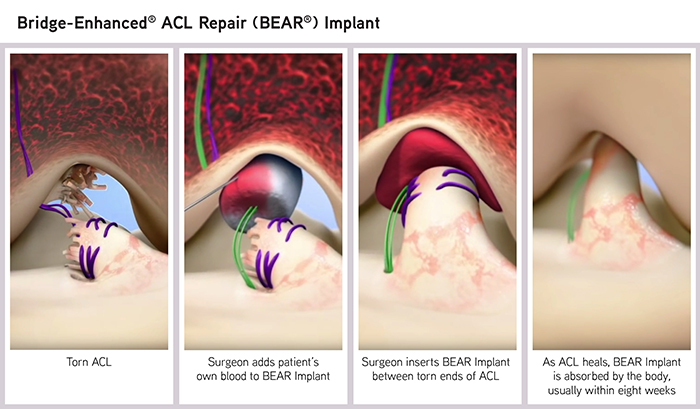
Studies reporting outcomes of ACL repairs have shown encouraging results, including promising early healing, good functional outcomes, and quicker initial recovery. However, the timeline for a full return to sport is the same as ACL reconstruction: approximately 9 months post-op.
ACL repair is a surgical procedure aimed at preserving the native anterior cruciate ligament (ACL) by reattaching the torn ligament rather than replacing it with a graft. This procedure is typically recommended for partial ACL tears or avulsion injuries, where the ligament remains largely intact and has the potential to heal. Dr. Bryan Penalosa, a board-certified orthopedic knee surgeon, specializes in advanced ACL repair techniques, including biologic augmentation and minimally invasive procedures, to optimize healing and restore knee stability. If you have sustained an ACL injury and want to explore whether ACL repair is the right option for you, schedule an appointment with Dr. Penalosa in Chicago, Naperville, or Oak Brook for an expert evaluation.
Lateral Extra-Articular Tenodesis (LET)
Lateral Extra-Articular Tenodesis (LET)
Anterolateral Ligament (ALL) Reconstruction and Lateral Extra-Articular Tenodesis (LET) are advanced surgical techniques used to stabilize the knee joint, particularly for individuals with ACL injuries. ACL injuries often cause knee instability, which can lead to additional damage to other structures of the knee. The ALL plays a significant role in knee stability, and its repair or reconstruction has become a focus in orthopedic medicine to reduce re-tear rates.
There are specific indications that may determine the need for ALL reconstruction or LET. These include patients with a high-grade pivot-shift (significant rotational instability), cases where previous ACL reconstruction has failed, and individuals at increased risk of future ACL injury due to factors such as young age, high activity level, or participation in pivoting sports. The decision to perform these procedures depends heavily on each patient’s circumstances and needs.
In recent years, research on ALL reconstruction and LET has increased, providing valuable insights into their effectiveness. A 2019 study published in the American Journal of Sports Medicine found that adding ALL reconstruction or LET to ACL reconstruction reduced the risk of graft failure and improved rotational stability. Moreover, these procedures help preserve the health of the cartilage and meniscus by reducing excessive load and stress on these structures after an ACL injury. Knee surgeon Dr. Bryan Penalosa has published extensive research on the biomechanics of these structures and the best techniques to address rotational instability in the setting of an ACL tear.
The techniques used in ALL reconstruction and LET vary. ALL reconstruction typically involves small incisions around the knee through which grafts are inserted to replace the damaged ligament. LET involves tightening the lateral structures (iliotibial band) of the knee to prevent excessive rotation and shift. Various methods can be employed depending on the surgeon’s preference and the patient’s anatomy.
Below are the different described techniques to reconstruct the anterolateral ligament.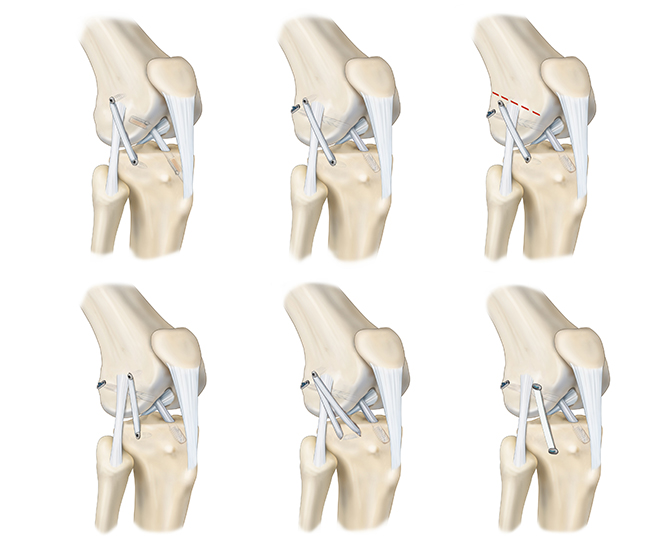
A lateral extraarticular tenodesis is represented below.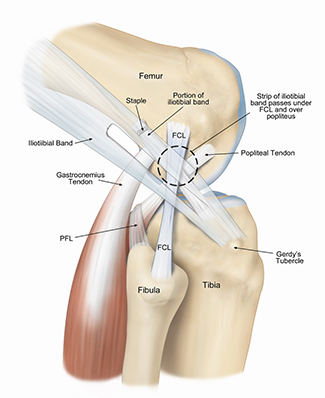
Prognosis after surgical intervention varies with each individual. Generally, the outlook is favorable, with a significant reduction in knee instability and improved long-term knee health. Notably, the addition of a lateral reconstruction does not lengthen the recovery time after an ACL reconstruction.
In conclusion, ALL reconstruction and LET are viable surgical interventions for knees with high-grade instability resulting from ACL injuries. These procedures, while complex, offer patients the opportunity to regain stability and return to their previous activities with an improved quality of life.
As with any medical intervention, it is crucial to consult a qualified medical professional. The field of orthopedic surgery is continually advancing, with ongoing research focused on optimizing treatments for ACL injuries. ALL reconstruction and LET represent significant strides in this area, offering improved knee stability and health for those affected by ACL injuries.
Lateral extra-articular tenodesis (LET) is often performed alongside ACL reconstruction to enhance knee stability, particularly in patients at risk for persistent rotational instability after an ACL injury. This procedure reinforces the lateral structures of the knee, reducing excessive rotational forces and lowering the risk of re-injury. LET is often recommended for high-risk athletes, individuals with hyperlaxity, or patients undergoing revision ACL surgery. Knee surgeon Dr. Bryan Penalosa specializes in advanced knee stabilization procedures, including LET, to improve long-term knee function and prevent future ligament injuries. If you are considering ACL reconstruction and want to explore whether LET is right for you, schedule an appointment with Dr. Penalosa in Chicago, Naperville, or Oak Brook for a personalized evaluation.
Overview
Pediatric ACL Injuries
The knee joint is made up of three bones: the femur (thigh bone), the tibia (shin bone), and the patella (kneecap). Inside the knee are two cruciate ligaments—the Anterior Cruciate Ligament (ACL) and the Posterior Cruciate Ligament (PCL)—which cross each other to form an X. The ACL is located at the front of the knee, while the PCL is at the back. Together, these ligaments help control front-to-back motion of the knee, as well as rotational stability.
What is the ACL?
The ACL is one of two cruciate ligaments in the knee joint that cross to form an X. It is a vital structure that helps stabilize the knee and control its movement. The primary function of the ACL is to prevent excessive forward movement of the tibia relative to the femur, as well as controlling rotational movements of the knee. It works in conjunction with other ligaments and structures in the knee to provide stability and support during activities like walking, running, jumping, and pivoting.

How does the ACL work?
The purpose of the ACL ligament is to prevent the tibia from sliding in front of the femur. The ACL also acts to stabilize the knee during rotation. The ACL runs diagonally from the back of the femur to the front of the tibia in order to provide this stability. The ACL ligament contains important nerve fibers that tell your brain where your knee is positioned, as well as vessels that help with the overall nutrition of the ACL.
How do ACL injuries occur?
Traumatic injury to the ACL occurs in athletes who participate in high-risk sports such as skiing, soccer, football, and basketball. The majority of ACL injuries result from a sharp twisting of the knee; sudden deceleration while cutting, pivoting, or performing sidestepping movements; an abrupt stop when running, or an awkward landing from a jump. Other, less common, causes include direct contact, a fall, or a traumatic accident. Women who participate in college sports, such as soccer, basketball, softball, lacrosse, or rugby are four times more likely than men to rupture their ACL.

What are the symptoms of an ACL injury?
When you injure your ACL, you may hear or feel a “pop” at the time of injury, often accompanied by buckling of the knee. There will be immediate and intense knee pain, swelling, inflammation, redness, and bruising. While the pain may decrease over time, the knee will likely remain unstable—especially when attempting to pivot or change direction quickly. You may also experience a loss of knee range of motion following an ACL injury.
Additional symptoms such as tenderness along the knee joint or locking of the knee may occur if there is an associated meniscus tear. Continuing regular activities with an ACL deficiency can lead to repeated instability episodes, which may cause further damage to other structures, including the meniscus and cartilage.
If you suspect an ACL injury, it is important to have it evaluated as soon as possible by a qualified knee surgeon, such as Dr. Bryan Penalosa.
What are the types of an ACL injury?
ACL injuries can be classified into different types based on the severity and extent of damage to the ACL fibers. The grading of severity depends on the amount of ligament disruption and the degree of knee instability following the injury. Accurately diagnosing the extent of an ACL injury is important, as the appropriate treatment plan varies depending on the type of injury.
Grade 1: ACL Sprain
An ACL injury that stretches the fibers of the ligament without causing a full-thickness tear is called an ACL sprain. This is the least severe type of ACL injury and often heals on its own with conservative treatment, including rest, ice, compression, elevation, oral anti-inflammatory medications, and physical therapy.
Grade 2: Partial ACL Tear
An ACL injury that tears some of the ligament fibers is called a partial tear. Patients with a partial tear may experience episodes of mild instability or pain, though severity can vary depending on the extent of the tear. In some cases, partial ACL tears may heal with conservative treatment, including rest, ice, compression, elevation, anti-inflammatory medications, physical therapy, and possibly the use of a specialty functional ACL brace.
If instability persists despite conservative treatment, surgical intervention may be considered. The decision to perform surgery depends on the degree of knee instability and the patient’s desire to return to sports. When discussing surgery for a partial ACL tear, knee surgeon Dr. Bryan Penalosa and his team may review both ACL repair and ACL reconstruction options. The best option depends on the location and extent of the partial tear.
Grade 3: Complete ACL Tear
A complete tear of the ACL occurs when the ligament is non-functional and requires surgical treatment. Professional athletes and most recreational athletes typically require surgery to return to play, especially if their sport involves pivoting, cutting, or lateral movements.
Pediatric ACL Injuries Non-Surgical Treatment
Pediatric ACL Injuries Non-Surgical Treatment
Can an ACL tear be treated without surgery?
In some cases, conservative treatment may be considered, especially for patients with incomplete ACL injuries such as an ACL sprain or partial ACL tear. Conservative treatment can be a successful option for patients who do not plan to return to pivoting sports or for those willing to wear a functional ACL brace to help control instability during activities that involve pivoting.
However, patients with full-thickness ACL tears who aim to return to high-risk sports will most likely require surgical intervention to regain their desired level of function and prevent further damage to other knee structures, including the menisci and cartilage, as a complete ACL tear will not heal on its own.
For patients who are candidates for conservative treatment, the focus is on reducing pain, swelling, and inflammation, while improving overall knee stability and function.
Rest and Activity Modification:
Initially following the injury, it’s essential to rest the knee and avoid activities that worsen the pain or lead to episodes of instability. As previously mentioned, repetitive episodes of instability can lead to further damage of other structures of the knee joint, including the menisci and cartilage. Therefore, activities that include pivoting, lateral movement, cutting, jumping, or quick deceleration from running may need to be avoided following an ACL injury in order to avoid instability episodes.
Oral Anti-Inflammatories, Ice, and Compression:
Oral anti-inflammatory and pain-relieving medications, such as Meloxicam, Naproxen, Advil, or Ibuprofen, may help to manage the pain and reduce inflammation of the knee following an ACL injury. Applying ice packs and compression to the knee can also help reduce swelling and inflammation. Remember to use a cloth or towel between the ice pack and your skin to avoid frostbite.
Physical Therapy
A structured physical therapy program can be beneficial for strengthening the muscles around the knee and improving overall joint stability. A physical therapist can guide you through exercises that focus on the quadriceps, hamstrings, and calf muscles to provide this additional support to the knee. Additionally, proprioceptive training can enhance knee stability. Proprioception is the body’s ability to sense joint position and movement, and improved proprioception can help with knee stability and control during activities. It is important to complete any home exercises that your physical therapist provides to you in order to optimize your recovery.
Functional ACL Brace:
A functional ACL brace is a type of knee brace designed to provide support and stability for individuals with an ACL injury or knee instability. While it cannot fully replace the function of the ACL, it helps limit movements that could put additional stress on the knee and reduces the risk of further injury during physical activity.
How a Functional ACL Brace Works
1. Mechanical Support
The brace provides mechanical support by limiting excessive movements, such as forward sliding of the tibia relative to the femur—the primary function of the ACL.
2. Stabilization
A functional brace helps stabilize the knee joint by restricting certain ranges of motion. For example, it can prevent excessive hyperextension and limit rotational movements that might strain the injured ACL or destabilize the knee.
3. Protection
By restricting certain movements and providing stability, the brace protects the knee from further injury during physical activity or sports, particularly high-risk activities like downhill skiing.
It is important to note that functional ACL braces are not a substitute for proper rehabilitation or surgical management, especially for complete ACL tears. They are most commonly used for individuals with partial ACL tears or those returning to sports like downhill skiing after ACL reconstruction.
Pediatric ACL Injuries Surgical Treatment
Pediatric ACL Injuries Surgical Treatment
What are the surgical options for an ACL injury?
Studies report that patients with an ACL injury may benefit from beginning physical therapy prior to surgery to strengthen the muscles surrounding the knee, particularly when their range of motion is limited. This is called prehabilitation. Once a patient has achieved at least 0–90 degrees of range of motion, knee surgeon Dr. Bryan Penalosa will discuss moving forward with surgical intervention. Generally, delaying surgery until pain, swelling, and inflammation have decreased—and range of motion has been restored with physical therapy—results in the best outcomes. The timing of ACL surgery is determined on a case-by-case basis, depending on the patient and their symptoms.
How is an ACL Injury Fixed?
Knee arthroscopy is a minimally invasive procedure used to view, assess, and treat a torn ACL. A torn meniscus, which is commonly found alongside an ACL rupture, can also be repaired during the procedure.
ACL injuries can be treated arthroscopically either by repairing the ACL or reconstructing the ACL. Only very specific types and locations of partial ACL tears are suitable for repair. Often, ACL reconstruction is the best option to achieve full recovery. The decision to repair versus reconstruct the ACL will be discussed during your appointment with Dr. Bryan Penalosa, based on your physical exam findings, MRI results, and the degree of your injury.
Surgical Options for ACL Injuries
ACL Reconstruction
ACL Repair
ACL Seatbelt Procedure
Pediatric ACL Reconstruction
Pediatric ACL Reconstruction
ACL Reconstruction: Graft Selection
ACL reconstruction involves replacing the ruptured (torn) ligament with a tendon graft. Graft tissue can be taken either from the patient (autograft) or from a tissue donor (allograft).
The choice of graft tissue and surgical technique depends on the severity of the injury, the patient’s age and activity level, desired outcome, and the knee surgeon’s preferred method. In pediatric cases, studies have shown that autografts generally provide better surgical outcomes and return-to-sport rates compared to allografts. Therefore, for pediatric ACL reconstructions, Dr. Bryan Penalosa recommends using an autograft.
Each type of autograft has its own advantages and disadvantages, so it is important to discuss any questions you may have with Dr. Penalosa during your appointment as you review the available graft options.
Bone-Tendon-Bone Patella Autograft
Bone-patellar tendon-bone (BTB) autograft ACL reconstruction has the longest proven track record of successful outcomes and is the technique to which all others are compared. In general, autografts have better long-term outcomes and a lower risk of complications compared to other graft types. The BTB Autograft, in particular, is the gold standard graft choice for ACL reconstructions of young, active patients because of its strong bone-to-bone fixation properties. The BTB autograft is harvested from the central third of the patient’s patellar tendon, along with bone plugs from the patella (kneecap) and tibia.
Quadriceps Tendon Autograft
More recently, the quadriceps tendon autograft has gained popularity as a graft source for ACL reconstruction; however, further data is necessary for a more widespread use. This graft is harvested from the patient’s quadriceps tendon, with or without bone plugs from the patella. This is typically the graft of choice when performing an ACL reconstruction on a pediatric patient whose growth plates remain open (ACL Reconstruction using Physeal-Sparing Technique). Open physes are an x-ray finding that ACL surgeon Dr. Chahla will bring to your attention during your consultation should your images reveal this.
Hamstring Tendon Autograft
In this technique, the semitendinosus and gracilis hamstring tendons are harvested from the patient’s own hamstring muscle. The hamstring tendon autograft is considered less invasive than the patellar tendon autograft. However, the re-tear rate associated with hamstring tendon autografts is higher compared to other graft choices. Additionally, the hamstring tendons act as secondary stabilizers of the knee joint.
For this reason, ACL surgeon Dr. Bryan Penalosa does not typically recommend the hamstring tendon autograft for patients undergoing ACL reconstruction.
ACL Reconstruction Pediatric Technique:
During your child’s consultation with ACL surgeon Dr. Bryan Penalosa, x-rays will be obtained. X-rays are a critical part of the pre-operative evaluation, as they allow Dr. Penalosa to assess your child’s growth plates (physes).
Growth plates are areas of developing cartilage at the ends of long bones, which are crucial for proper bone growth and development in children and adolescents. At this stage, children and adolescents have open growth plates at the ends of their bones. As they mature, the growth plates gradually close. A hand x-ray can help determine how much growth remains, which is an important consideration when planning ACL surgery for pediatric patients.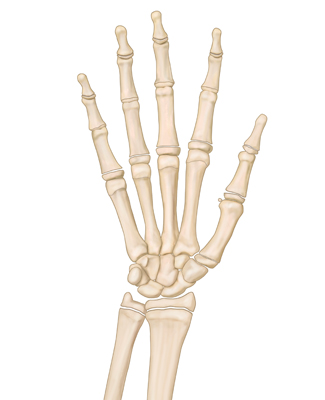
In traditional ACL reconstruction, the tunnels created for the new ACL graft pass through the physes (growth plates) of the bone. This is typically not a concern for patients with closed physes. However, for growing children and adolescents with open physes visible on x-ray, knee surgeon Dr. Bryan Penalosa recommends a physeal-sparing ACL reconstruction technique. This approach preserves the growth plates and helps avoid complications such as growth disturbances or limb length discrepancies.
Physeal-sparing ACL reconstruction is specifically designed for pediatric patients, taking into account the presence of open growth plates. Using this technique, Dr. Penalosa can successfully reconstruct the ACL while maintaining the integrity of the physes, preventing interference with natural bone growth and development. This is achieved through careful surgical planning and precise tunnel positioning tailored to the unique anatomy of growing bones.

The primary goal of physeal-sparing ACL reconstruction is to provide a safe and effective solution for ACL injuries in pediatric patients without compromising their future growth. By performing this technique, knee surgeon Dr. Bryan Penalosa prioritizes the long-term health and functionality of the knee joint, minimizes the risk of complications related to growth plate damage, and allows your child to return to normal activities after recovery.
If the growth plates are nearly closed and the child’s height is similar to that of their parents, an adult ACL reconstruction technique can be performed instead.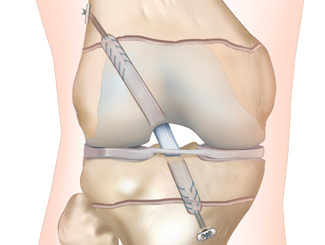
Pediatric ACL Repair
Pediatric ACL Repair
In specific cases, ACL repair may be considered as a treatment option for a partial ACL injury. The location of the partial tear plays a critical role in the decision to repair, due to the ACL’s vascular supply and healing potential. The Sherman classification is used to describe the location of ACL tears and identify those suitable for potential repair:
Sherman Type I: ACL avulsion injury from the top of the femoral notch.
Sherman Type II: Tear through the substance of the upper one-third of the ACL.
Primary Sherman Type I or II injuries with good tissue quality and no other ligament injuries can be considered for repair. To optimize tissue quality, it is important to perform ACL repair as soon as possible once the patient has achieved 0–90 degrees of range of motion—ideally within 40 days of injury.
Arthroscopic primary repair is minimally invasive. Since no grafts are needed, the surgical incision is smaller than in ACL reconstruction using an autograft. Nonmetal anchors and sutures are used to reattach and re-tension the ACL remnant. The goal of the procedure is to preserve the native ACL, maintaining the ligament’s nerve endings and blood supply, which promotes healing and preserves proprioception.
When an ACL injury is suitable for arthroscopic repair, knee surgeon Dr. Bryan Penalosa may also discuss the option of augmenting the repair with the BEAR technique (Bridge-Enhanced ACL Repair).
The ACL is naturally unable to heal on its own because blood clots cannot form within the joint due to the presence of synovial fluid, which prevents the healing components of blood—such as platelets, coagulation factors, growth factors, and fibrin—from reaching the damaged ACL tissue.
The BEAR implant is designed to hold the body’s own blood within the gap of the ACL injury, allowing a blood clot to form and initiate the natural healing process. Essentially, the BEAR implant acts as a bridge between the torn edges of the ACL during healing.
Although short-term studies on the BEAR implant have shown promising results, research is ongoing to fully understand the long-term outcomes of this surgical technique.
Studies reporting outcomes of ACL repairs have shown encouraging results, including early healing potential, good functional outcomes, and faster initial recovery. However, the timeline for a full return to sport remains similar to ACL reconstruction, typically around 9 months post-operation.
Pediatric ACL Seatbelt Procedure
Pediatric ACL Seatbelt Procedure
Anterolateral Ligament (ALL) reconstruction and lateral extra-articular tenodesis (LET) are advanced surgical techniques used to stabilize the knee joint, particularly in patients with ACL injuries. ACL injuries often cause knee instability, which can lead to additional damage to other structures within the knee. The ALL plays a critical role in knee stability, and its repair or reconstruction has become an important focus in orthopedic medicine to help reduce re-tear rates.
Indications for ALL Reconstruction or LET
Certain factors may indicate the need for ALL reconstruction or LET, including:
High-grade pivot-shift (significant rotational instability)
Failed previous ACL reconstruction
Increased risk of future ACL injury due to young age, high activity level, or involvement in pivoting sports
The decision to perform these procedures depends on the individual patient’s circumstances and needs.
Evidence Supporting ALL Reconstruction and LET
Recent research has highlighted the effectiveness of these procedures. A 2019 study published in the American Journal of Sports Medicine found that adding ALL reconstruction or LET to ACL reconstruction:
Reduces the chance of graft failure
Improves rotational stability
Helps preserve cartilage and meniscus health by reducing excessive load and stress after an ACL injury
Knee surgeon Dr. Bryan Penalosa has extensive knowledge in the biomechanics of these structures and the optimal techniques to address rotational instability in ACL injuries.
Surgical Techniques
ALL Reconstruction: Small incisions are made around the knee, and grafts are inserted to replace the damaged ligament.
LET Procedure: Involves tightening the lateral structures (iliotibial band) of the knee to limit excess rotation and shift.
The choice of technique varies based on the surgeon’s preference and the patient’s anatomy.
A lateral extraarticular tenodesis is represented below
Prognosis and Outcomes
The prognosis after surgical intervention varies for each individual. Generally, outcomes are favorable, with a significant reduction in knee instability and improved long-term knee health. Notably, the addition of a lateral reconstruction does not extend the overall recovery time following ACL reconstruction.
In conclusion, ALL reconstruction and LET are viable surgical interventions for knees with high-grade instability resulting from ACL injuries. While these procedures are complex, they provide patients with an opportunity to regain stability and return to previous activities with an improved quality of life.
As with any medical procedure, it is crucial to consult a qualified orthopedic professional. Ongoing research continues to improve the effectiveness of ACL treatments. ALL reconstruction and LET represent significant advancements in knee stabilization, offering promising outcomes for patients affected by ACL injuries.
Recovering from Pediatric ACL Surgery
Recovering from Pediatric ACL Surgery
What is the expected recovery from an ACL injury?
ACL Surgery Recovery and Rehabilitation
Recovery from ACL surgery begins on the first day after the operation. Immediate physical therapy is crucial to restore range of motion and quadriceps activation. Subsequent phases of ACL rehabilitation are carefully structured to enhance recovery and reduce the risk of future injury. For detailed guidance, please click the link at the bottom of this page to view our full ACL reconstruction post-operative rehabilitation protocol and instructions.
The average recovery period for ACL reconstruction or repair is 6–9 months, including full rehabilitation to restore range of motion, strengthen muscles, and regain balance. Even after completing rehabilitation, injury prevention remains essential to avoid subsequent knee injuries.
Recovering from ACL Surgery
ACL Surgery Recovery and Rehabilitation
Recovery from ACL surgery begins the day after your operation. Immediate physical therapy is essential for optimal restoration of range of motion and quadriceps activation. The subsequent phases of ACL rehabilitation are carefully structured to enhance recovery and prevent future injury. For detailed guidance, please see the full ACL reconstruction post-operative rehabilitation protocol and instructions linked at the bottom of this page.
The average recovery time for ACL reconstruction or repair is 6–9 months, which includes full rehabilitation to restore range of motion, strengthen muscles, and regain balance. Even after completing rehabilitation, injury prevention remains critical to minimize the risk of future knee injuries.
Patient Resources
Orthopedic surgeon Dr. Bryan Penalosa and his team are dedicated to providing an industry-leading patient experience—one that is smooth, efficient, and convenient. Our team has compiled a comprehensive set of orthopedic patient resources to assist you with insurance information, patient forms, and much more.
Explore the patient resources below to learn more.
- Preparing for Surgery
- Traveling for Surgery
- Pre-Operative Clearance
- Peri-Operative Nutrition
- Post-Operative Instructions
- Post-Operative Physical Therapy
- Post-Operative Medications
- Durable Medical Equipment
- Billing & Insurance
- Patient Portal
- Medical Records
- Patient IQ
- Clinical Case and Imaging Review
- Ongoing Clinical Trials
- Sports Performance Center
